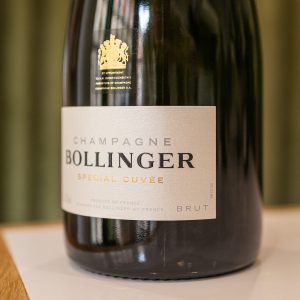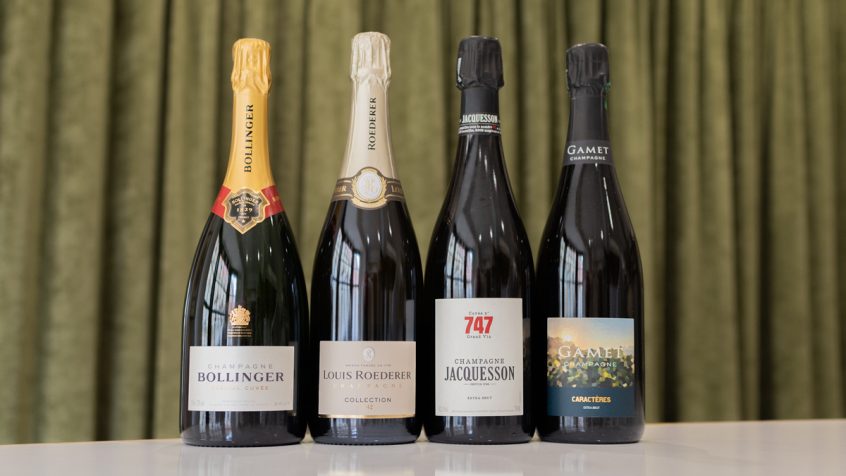Non-vintage Champagne can essentially be thought of as the ‘house wine’ of any Maison. In Champagne, winemakers work tirelessly to blend a combination of vintages in order to create a house-style which is distinctive, characterful, and consistent. These wines typically make up around 90% of the regions total output – so they are key for defining the Champagne market worldwide.
Considering Climate
As a region, Champagne sees quite a lot of unpredictable weather. They can suffer cold winters which stretch into spring. Whilst summers are usually bright and warm, some years can be overcast and wet. This culminates in a lot of uncertainty surrounding quality and quantity of harvests. Where other regions may leave fruit on the vine longer to achieve ideal ripeness, in Champagne this is not possible, as fruit needs to have lower sugar, in order to achieve a low alcohol level in your base wine. This variability in weather results in vintages showing noticeably different acidity, freshness and character – which is not always desirable.
Large brands who dominated the region found that they were not achieving consistency, so started blending in order to achieve this. As a result, a house can produce an excellent wine every year, regardless of the weather! As a bonus – when they do endure a fantastic year, they can produce a single-vintage wine, adding diversity to their portfolio, whilst maintaining their strong reputations for producing great quality wines.
Reserve Wines
Interestingly, it is actually law for Champagne houses to keep back some wine every year, which will later be used for non-vintage wines. These wines are called ‘reserve wines’, and they are a powerful tool for top NV production. Most of these reserve wines are stored in stainless steel vats, which allow the wine to age slowly, maintaining its freshness.
Some houses utilise a portion of reserve wines which incorporate oak, giving further complexity and depth to their NV wines. Others choose to focus their blends on younger reser ve wines, ensuring that a light and bright style is maintained.
ve wines, ensuring that a light and bright style is maintained.
There is also a particular kind of reserve wine which is often favoured by smaller, or medium-sized producers, and this is a ‘perpetual reserve’. It usually operates in a similar way to a solera system, where a single reserve is drawn from each year, then topped up. This in effect creates a new multi-vintage cuvée, with unrivalled character! These wines are blended into a NV wine to add intrigue, balanced by the freshness of other reserves. A fantastic example of this is the Gamet Caracteres Champagne, which uses a perpetual reserve from 1999, giving it a unique oxidised character followed by a long freshness.
The Art of Blending
Blending is the key to producing an excellent NV Champagne, not only do you need to blend grape varietals, but you also need to decide which proportions of which various reserve wines to include.
 This process first begins with a base wine, this is essentially the vintage where the main body of the wine comes from. Most producers tend to use between 50-80% of a single base year, with the rest taken from several reserve wines. This does mean that whilst a NV should be the same style from year to year, you do tend to see the qualities of the base year coming through in each release. For example, wines a base year of 2015 show real depth, and rich fruit character due to the hot temperatures throughout the growing season.
This process first begins with a base wine, this is essentially the vintage where the main body of the wine comes from. Most producers tend to use between 50-80% of a single base year, with the rest taken from several reserve wines. This does mean that whilst a NV should be the same style from year to year, you do tend to see the qualities of the base year coming through in each release. For example, wines a base year of 2015 show real depth, and rich fruit character due to the hot temperatures throughout the growing season.
Many producers argue that multi-vintage blending can actually produce better wines than those of a single-vintage, as it adds further depth to the wine. Some houses focus on releasing ‘expressions’ of NV wines, where they number or name each release, rather than releasing all their NV wines under the same label. Producers like Krug and Jacquesson paved the way with their numbered cuvées. This way, consumers can distinguish between releases from year to year which each focus on different bases and blends. This has slowly become more mainstream, with producers like Louis Roederer following suit with their ‘collection’ wines.
Whether released simply as a non-vintage, or as an individual expression, these wines still showcase house style first and foremost, without the truly distinct variation of a single-vintage champagne.
The Brands
Though vintage champagne is perceived as being the finer category, it is actually the NV wines which a producer stakes their reputation on. These wines are usually most consumers first meeting with a house, and of course, first impressions count!
Finding a terrific NV wine, your own house style shall we say, is just as exciting as discovering a fantastic vintage. So it is unsurprising that so much time and effort goes into producing these wines year on year.
Branding is key is crafting these wines, with many houses actually leaving non-vintage off their label, instead creating their own unique name for the wine will be viewed as their bread and butter. Bollinger has Special Cuvée, Veuve Clicquot has Yellow Label, and Laurent Perrier has La Cuvée – these names are synonymous with the houses themselves, they are at the very core of the brands identity, so of course they need to knock it out the park.

